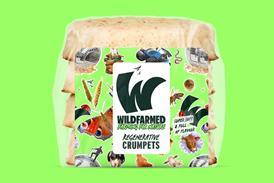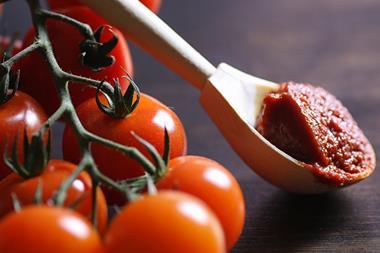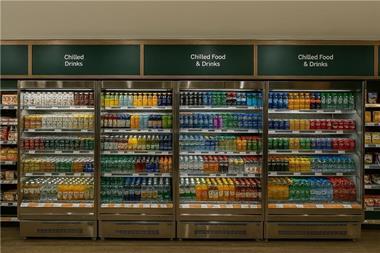n Are premium goods a shortlived pandering to snobbish self indulgence? Or do they represent a long-term trend of lasting benefit to the entire food industry, asks Belinda Gannaway
British food culture is changing, becoming increasingly faddish and more importantly lavish. The average shopper is trading up and the premium market is among the fastest growing of any food industry sector. It is driving value growth where there is any to be had and preventing sector meltdown where there is not.
The premium market may once have been confined to the food halls for the likes of which Harrods and Selfridges were famed, but it is now widespread. Even own label, originally the cheaper alternative, has gone upmarket and is proving a significant weapon in the battle for market share.
Mintel estimates that the value of premium bread, ice cream, jams and preserves, ready meals and sweet biscuits increased from £831m in 1994 to £1.3bn in 1999 a jump of 60%.
But by slapping elaborate packaging and higher prices on to foods both new and established, what is the trade actually offering the consumer? Is this premiumisation' fuelling an unnecessary and perhaps unsustainable snobbery among consumers?
Is the retailers' drive to drag consumers into the higher margin end of every category, speeding the creation of a two tier market where those who can trade up and those who can't are stuck with the bargain basement goods?
Snobbery is about as British as tea and biscuits. And oneupmanship in food is not new. But the supermarket was supposed to be the great leveller, selling the same food at the same price (or thereabouts) to Mrs Jones in the manor as well as Smith her retired gardener.
The unlevelling of the playing field was inevitable. As Mintel reports this month: "Value is added by selling better quality base ingredients in a convenient format and it is the aim of all retailers to encourage trading up.
"Unashamedly indulgent ranges within a mainstream grocery offering, such as Tesco Finest, trade on these aspects and have been vital in broadening retail offers, hence expanding the consumer base and improving overall grocery share."
And the desire to pull shoppers up the ladder is not limited to the retailer and processor.
There is a growing acknowledgement of the need to protect EU agriculture from overseas competition. Increasing emphasis on improved quality take hormone free beef, organic and, increasingly, GM free is part of that.
Pressure group the Food Commission among others is a great supporter of the promotion of real food values and the extension of organic and GM free ranges by the multiples.
These reasons' for consumption often based around environmental, animal welfare and health concerns feed the desire to move away from commoditisation and drive the creation of specialist markets.
With disposable income on the rise throughout the '90s and forecast to continue on an upward curve for the next four years at least consumers are financially equipped to spend more.
While there was reluctance to trade up in the years immediately following the last recession, growth rates in consumer expenditure had caught up with growth in personal disposable income by 1998.
While there are many aspects fuelling the trend for more elaborate cuisine in the home broadened food horizons from a burgeoning restaurant and travel culture and a new found love affair for home entertaining for starters it would be wrong to underestimate the pure financial logic behind increased demand.
And the future for top notch nosh looks promising with 31% of respondents to a Mintel survey saying they would spend more on quality food if they were convinced it represented value for money in terms of the pleasure that could be derived from eating it. Safeway says it receives 10 times the number of requests for premium, specialist and locally sourced products compared to 10 years ago.
This is not restricted to the highest earners. But neither is there evidence the economy lines (shrinking in value and volume since their peak in 1995) are the sole domain of the lowest incomes. In some categories tinned tomatoes and juice the higher social groups are the most regular economy line buyers. Some 47% of ABC1s buy economy lines regularly.
There is certainly a growing savviness in food which is producing extremes at both the top and bottom. There is no doubt there is a growing band of food snoots out there it happens in everything else we can throw money at just as there is a collection of well heeled bargain hunters.
And somewhere in the middle is a growing element of sophistication, understanding and confidence about new foods. There are obvious parallels with the pattern of wine consumption 20 years ago.
Perhaps it is about time the Brits caught up with the rest of the food interested world (including most of the EU) with an understanding of, and desire for, good food and cooking.
Gareth Jones of food consultancy Longhouse says: "More interesting foods, in every category, are now there for those with a more than cursory interest in food. This has to be better than filling our supermarkets with endless aisles of sugary, salt-rich breakfast cereals, biscuits and snack foods."
The store groups are now far more adept at matching ranges to local consumers. Safeway supply chain operations director Mark Aylwin says social factors rather than pure economics are now the critical element in determining that mix.
"We start with the basic range and then look at the social makeup of an area. That's always been in the mind of the manager. Now there's a lot more support from head office. Consumers now are a lot more articulate in what they want and much more likely to demand that from the manager."
But while the push may be as big as the pull in the trade's upward mobilisation, retailers and manufacturers should be wary of mere superficiality. Sticking ideal for stir frying' on curly kale when any attempt to serve after three minutes in a wok would result in stomach ache is neither going to educate nor encourage repeat purchase.
Manufacturers and retailers must also beware of adding to prices without adding to the offer. The most likely reason given by consumers for spending more than would usually be the case is if a special offer were available. This does not help grow the sector long term a constant round of special offers leads to less easy acceptance of pricing policy and conversely less likelihood to trade up and if first-time buyers are not simultaneously eased into an appreciation of what it is they are paying for, they will not repeat the purchase. If a multinational yellow fat processor wants to hog shelf space with 18 different types of margarine, it must ensure the top end consumer is getting the real McCoy.
Yet value for money remains high on premium shoppers' list of priorities recorded by Mintel. Willingness to trade up even by families on a low income reflects an appreciation of value for money that does not automatically mean cheapest on display.
But how will premium products and pricing sit in this new price war era?
Where supermarkets are once again selling themselves on the bottom line, the likes of Tesco, which has built its brand spectacularly on the back of such inventions as Tesco Finest, will need to tread carefully if it is to retain its new found position as a purveyor, rather than merely a stacker, of good food.
This will be especially critical as we move into an online world where people shop in two distinct ways at home for the bulk, commodity purchases and in store for the touchy feely deli style foods. The multiples need to ensure they maintain their grasp on the good food image they have successfully built if they are to ensure shoppers keep coming into their stores.
It may smack of snobbery at the extreme end, but the trend towards premium foods represents a genuine groundswell of sophistication in what we know about and look for in food if not the culinary skills to match.
And rising economic fortunes should ensure this continues for the next few years at least.
The willingness of retailers and manufacturers to offer new and alternative foods, both prompted by consumer interest and generating it, can only serve to benefit the entire industry and the British diet. n
{{COVER FEATURE }}
Close menu
- Home
- Retail & Wholesale
-
Products & Suppliers
- Back to parent navigation item
- Products & Suppliers
-
Product Categories:
- Back to parent navigation item
- Product Categories:
- Alcoholic drinks
- Bakery
- Cereals & breakfast
- Cheese
- Chicken & poultry
- Chocolate
- Confectionery
- Crisps, nuts & snacks
- Dairy
- Fish
- Fresh produce
- Frozen
- Household
- Meat
- Own Label
- Sauces & condiments
- Seasonal
- Soft drinks
- Vaping
- Vegan & plant-based
- World foods
- Suppliers
- People
- Reports & Data
-
Topics A-Z
- Back to parent navigation item
- Topics A-Z
-
Popular topics:
- Back to parent navigation item
- Popular topics:
- Cost of living crisis
- Crime
- Deposit Return Schemes
- Finance
- Government & Regulation
- Health
- Inflation
- Loyalty
- Marketing
- Mergers & Acquisitions
- New Product Development
- Sourcing
- Supply chain
- Sustainability & environment
- Technology
- Ultra Processed Foods
- Vaping
- A-Z all topics
- Content by type:
- Events
- Ask iA (beta)
- Subscribe now
Sign in to comment on this article
Not logged in before? Register for FREE guest access today.
You will be able to:
- Read more stories
- Receive daily newsletters
- Comment on stories
Advert















No comments yet